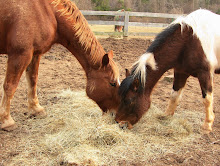Riding Balance Basics |
| Written by Nancy-Wesolek-Sterrett |
All of your joints connect in sequence so all of your joints need to allow some movement in order for you to follow your horse's motion. However, since the seat bones (the lowest point of your bony pelvic girdle, which also forms your hip joint sockets) directly contact the horse's back, your hips absorb more of the horse's motion than any other joint. Your core muscles, those that support your lower back and abdomen, must be firm and strong enough to lift your mid-section so that your hips can swing with the horse's movement in an upward tipping motion. Your thigh muscles must be long and relaxed which requires complementary stretch in the hip flexors and strength in the hamstrings. Your knee and ankle joints must also be relaxed. With complete relaxation of the muscles from hip to toe, you enable your hips to move, following the swing of your horse's back. Muscle tension anywhere in the body, such as grippy knees or locked ankles, will lock the hip and cause the rider to bounce. When your hips are in a neutral position at the halt, your spine should be straight and your back should be flat. The hips should neither tip forward (an arched back) nor tip back (a rounded back). From this neutral position, the hip simply swings in a forward and upward motion toward the hand with every step of the horse. The hip swings in all three gaits, with each gait slightly different in the amount of swing and rhythm. It is easy to line up your ear, shoulder, hip and heel in a line perpendicular to the ground when your horse is standing still. Maintaining that alignment when the horse moves off at the walk, trot, or canter is the challenge. Since, as previously noted, all of the joints are connected, you can develop awareness of hip motion by moving other body parts such as the head or the leg. To feel the motion of swinging and tipping your hips forward from the ground, stand with your back and heels against a wall then try to simply move your hips forward by contracting your upper and lower abdominal muscles. This may seem like a simple exercise but many riders cannot swing their hips forward without contracting other muscles. Riders with weak abs or strong gluteus muscles often try to use their gluteus muscles to swing their hips. Tight gluteus muscles cause the rider to bounce. If your core muscles are weak, learning to swing your hips will be difficult. Strength training exercises for your core muscles, separate from your riding exercises, are helpful. Do not confuse strength with tension. Tension usually comes from two sources. First, riders who are fearful or insecure may tense their muscles and grip in an attempt to keep themselves from bouncing and feel more in control. However, this tension causes more bouncing. Ironically, they would be more secure if they could relax their muscles because this would allow their joints to flex so they can swing their hips and stay in rhythm with the horse. Second, riders with weak muscles often tense them as compensation for their lack of strength. Strong but relaxed muscles can flex, allowing the rider's hip joints to absorb the horse's motion while maintaining a balanced position over the horse's center of gravity. Weak or tense core, hip and thigh muscles are stiff and inflexible. This creates telltale bounces in the saddle at each stride. Stiffness can also be a matter of age or genetics. We all start to lose flexibility around 16 years of age if we do not actively stretch every day. The good news is that, with daily stretching, anyone can regain his or her lost flexibility with time. Some people are just stiff or tense by nature. Have you ever known someone who made you tense just being around them? Even these riders, however, can gain greater flexibility by doing stretching exercises off their horses. Yoga is a particularly helpful stretching program that also teaches rhythmic breathing patterns that can help people relax and release muscular tension. Ironically, extreme flexibility can also work against a rider. Some riders tend to be very flexible while lacking strength. These riders are relaxed enough to swing with their horse, but they lack the strong, firm muscles necessary to stay organized while coordinating and applying the aids. All riders have strengths and weaknesses which they struggle to overcome. With practice and hard work, however, any rider can learn to follow the motion of their horse. Each of the horse's gaits has its own distinctive hip swing and rhythm. Once you learn to follow the motion of each of your horse's individual gaits, you can then master the use of one of your most influential aids—your seat. We will discuss these distinctive swings and rhythms more in future articles.
The above article may not reflect the views of W.O.H.A.T. and are the views and property of the author.
|
Loretta
the natural horseman
clear communication/visible results






